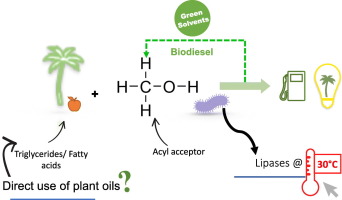当前位置:
X-MOL 学术
›
Fuel Process. Technol.
›
论文详情
Our official English website, www.x-mol.net, welcomes your
feedback! (Note: you will need to create a separate account there.)
Biodiesel-mediated biodiesel production: A recombinant Fusarium heterosporum lipase-catalyzed transesterification of crude plant oils
Fuel Processing Technology ( IF 7.2 ) Pub Date : 2020-03-01 , DOI: 10.1016/j.fuproc.2019.106278 Emmanuel Quayson , Jerome Amoah , Nova Rachmadona , Shinji Hama , Ayumi Yoshida , Akihiko Kondo , Chiaki Ogino
Fuel Processing Technology ( IF 7.2 ) Pub Date : 2020-03-01 , DOI: 10.1016/j.fuproc.2019.106278 Emmanuel Quayson , Jerome Amoah , Nova Rachmadona , Shinji Hama , Ayumi Yoshida , Akihiko Kondo , Chiaki Ogino

|
Abstract Production of biodiesel from unrefined plant-derived oils has been considerably investigated but, to date, there appears to be a limit by phospholine gums and other contaminants in its conversion to biodiesel. The presence of such contaminants increases the melting point of the oils, thereby, making it unfavorable for lipase-catalyzed reactions at mild temperatures. Here, to circumvent this limiting effect, we explore the potential of biodiesel as a replacement for conventional organic solvents in solubilizing gum-formation contaminants in crude palm oil (CPO). A strategy of 1:1 CPO/biodiesel molar amount consolidates degumming and trans/esterification into one-step using immobilized Aspergillus oryzae expressing Fusarium heterosporum lipase. The innocuous biodiesel solvent not only ensured a 98.8 wt% biodiesel yield but also improved the catalytic activity of the whole-cell lipase. This allowed repeated use of the recombinant lipase in nine consecutive batches. At room temperature, biodiesel as a solvent saves on post-separation and reduces environmental footprints of the biodiesel production process.
中文翻译:

生物柴油介导的生物柴油生产:重组异孢镰刀菌脂肪酶催化的粗植物油的酯交换
摘要 对从未精炼的植物油生产生物柴油进行了大量研究,但迄今为止,磷碱胶和其他污染物在其转化为生物柴油方面似乎存在限制。此类污染物的存在会增加油的熔点,从而使其不利于温和温度下的脂肪酶催化反应。在这里,为了规避这种限制效应,我们探索了生物柴油作为传统有机溶剂的替代品,在溶解毛棕榈油 (CPO) 中形成胶质的污染物方面的潜力。1:1 CPO/生物柴油摩尔量的策略使用表达异孢镰孢脂肪酶的固定化米曲霉将脱胶和反式/酯化合并为一个步骤。无害的生物柴油溶剂不仅确保了 98。8 wt% 的生物柴油产量也提高了全细胞脂肪酶的催化活性。这允许在九个连续批次中重复使用重组脂肪酶。在室温下,生物柴油作为溶剂可节省后分离并减少生物柴油生产过程的环境足迹。
更新日期:2020-03-01
中文翻译:

生物柴油介导的生物柴油生产:重组异孢镰刀菌脂肪酶催化的粗植物油的酯交换
摘要 对从未精炼的植物油生产生物柴油进行了大量研究,但迄今为止,磷碱胶和其他污染物在其转化为生物柴油方面似乎存在限制。此类污染物的存在会增加油的熔点,从而使其不利于温和温度下的脂肪酶催化反应。在这里,为了规避这种限制效应,我们探索了生物柴油作为传统有机溶剂的替代品,在溶解毛棕榈油 (CPO) 中形成胶质的污染物方面的潜力。1:1 CPO/生物柴油摩尔量的策略使用表达异孢镰孢脂肪酶的固定化米曲霉将脱胶和反式/酯化合并为一个步骤。无害的生物柴油溶剂不仅确保了 98。8 wt% 的生物柴油产量也提高了全细胞脂肪酶的催化活性。这允许在九个连续批次中重复使用重组脂肪酶。在室温下,生物柴油作为溶剂可节省后分离并减少生物柴油生产过程的环境足迹。











































 京公网安备 11010802027423号
京公网安备 11010802027423号